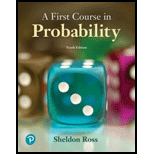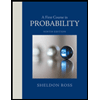
EBK FIRST COURSE IN PROBABILITY, A
10th Edition
ISBN: 9780134753683
Author: Ross
Publisher: VST
expand_more
expand_more
format_list_bulleted
Question
Chapter 10, Problem 10.13P
To determine
To Prove: The
Expert Solution & Answer
Want to see the full answer?
Check out a sample textbook solution
Students have asked these similar questions
Q2
H
let x(+) = &cos (Ait+U) and.
4(+) = ß cos(12t +V), where d. B. 1. In Constants
and U,V indep.rus have uniform dist. (-π,π)
Show that:
①Rxy (+,4+1)=0 @ Rxy (++) = cos [
when U=V
Q3 let x(t) is stochastic process with Wss
-121
e,
and Rx ltst+1) = ( 2, show that
E(X) =
E(XS-X₁)² = 2(-1).
Qu let x(t) = U Cost + (V+1) Sint, tεIR.
where UV indep.rus, and let E (U)-E(V)=0
and E(U) = E(V) = 1, show that
Cov (Xt, Xs) = K (t,s) = cos(s-t) X(+) is not
WSS.
Patterns in Floor Tiling A square floor is to be tiled with square tiles as shown. There are blue tiles on the main diagonals and red tiles everywhere else.
In all cases, both blue and red tiles must be used. and the two diagonals must have a common blue tile at the center of the floor.
If 81 blue tiles will be used, how many red tiles will be needed?
For what numbers in place of 81 would this problem still be solvable?
Find an expression in k giving the number of red tiles required in general.
At a BBQ, you can choose to eat a burger, hotdog or pizza. you can choose to drink water, juice or pop. If you choose your meal at random, what is the probability that you will choose juice and a hot dog? What is the probability that you will not choose a burger and choose either water or pop?
Chapter 10 Solutions
EBK FIRST COURSE IN PROBABILITY, A
Ch. 10 - The following algorithm will generate a random...Ch. 10 - Prob. 10.2PCh. 10 - Give a technique for simulating a random variable...Ch. 10 - Present a method for simulating a random variable...Ch. 10 - Use the inverse transformation method to present...Ch. 10 - Give a method for simulating a random variable...Ch. 10 - Let F be the distribution functionF(x)=xn0x1 a....Ch. 10 - Prob. 10.8PCh. 10 - Suppose we have a method for simulating random...Ch. 10 - Prob. 10.10P
Ch. 10 - Use the rejection method with g(x)=1,0x1, to...Ch. 10 - Prob. 10.12PCh. 10 - Prob. 10.13PCh. 10 - Prob. 10.14PCh. 10 - Prob. 10.15PCh. 10 - Let X be a random variable on (0, 1) whose density...Ch. 10 - Prob. 10.1STPECh. 10 - Prob. 10.2STPECh. 10 - Prob. 10.3STPECh. 10 - If X is a normal random variable with mean and...Ch. 10 - Prob. 10.5STPE
Knowledge Booster
Learn more about
Need a deep-dive on the concept behind this application? Look no further. Learn more about this topic, probability and related others by exploring similar questions and additional content below.Similar questions
- a card is drawn from a standard deck of 52 cards. If a card is choosen at random, what is the probability that the card is a)heart b)a face card or c)a spade or 10arrow_forwardin a coffee shop, 160 customers came in. Of these, 60 bought coffe and cake and the rest ordered just coffee. determine the probability that the next person will buy coffee and cakearrow_forwardTwo dice are rolled and their sum calculated. Draw a table to show all of the possibilities. Determine the theoretical probability of rolling a sum of 7. And determine the theoretical probability of rolling a sum greater than 9arrow_forward
- A football player makes 350 out of every 400 passes he throws. In a game he usually throws 26 passes. Estimate how many of these passes will be successfularrow_forwardThe joint density function of two continuous random variables X and Y is: p(x, y) = {Kcos(x + y) Find (i) the constant K 0 0arrow_forwardp(x,y) = {e-x -(x+y) 0 x ≥ 0, y ≥ 0 otherwise find x,y,Exy, by Охarrow_forwardIf X is a continuous random variable having pdf as shown. Find a) the constant k b) P(X>1) c) X, X², 0%, standard deviation. n(x) k -2 -1 0 1 2arrow_forwardarrow_back_iosSEE MORE QUESTIONSarrow_forward_iosRecommended textbooks for you
 A First Course in Probability (10th Edition)ProbabilityISBN:9780134753119Author:Sheldon RossPublisher:PEARSON
A First Course in Probability (10th Edition)ProbabilityISBN:9780134753119Author:Sheldon RossPublisher:PEARSON
 A First Course in Probability (10th Edition)ProbabilityISBN:9780134753119Author:Sheldon RossPublisher:PEARSON
A First Course in Probability (10th Edition)ProbabilityISBN:9780134753119Author:Sheldon RossPublisher:PEARSON
Basic Differentiation Rules For Derivatives; Author: The Organic Chemistry Tutor;https://www.youtube.com/watch?v=IvLpN1G1Ncg;License: Standard YouTube License, CC-BY